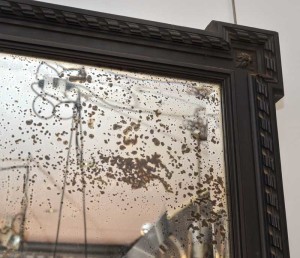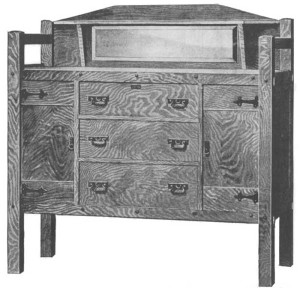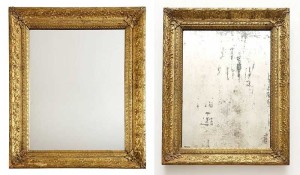Small Home Gazette, Winter 2014
Is Your Looking Glass Showing Age?
Mirror, mirror on the wall, are you the grayest of them all?
 Vintage mirrors can often show their age in the most unflattering ways: pinpoints of gray converge to dull the reflection, or whole areas go dark or blotchy. Some consider this a welcome part of the aging process—akin to a piece of metal or wood acquiring a patina that hints at a long, colorful life. But others value a mirror’s basic purpose—reflectivity—more than its age.
Vintage mirrors can often show their age in the most unflattering ways: pinpoints of gray converge to dull the reflection, or whole areas go dark or blotchy. Some consider this a welcome part of the aging process—akin to a piece of metal or wood acquiring a patina that hints at a long, colorful life. But others value a mirror’s basic purpose—reflectivity—more than its age.
What are your options if you want to see a clear image in your vintage mirror? What should you consider before restoring the mirror? Is a new mirror appropriate?
You Can, But Should You?
The first rule of dealing with antique furniture is often “do no harm.” Cam Quintal, co-owner of Eastwood Gallery of St. Paul, says he has rarely restored or replaced a mirror. “If the condition of the mirror is a significant distraction, then I’d consider it,” Quintal says.
However, if the mirror is in an historically precious frame or piece of furniture, restoration or replacement could detract from the value. A new, shiny mirror would alert everyone that the piece has had work done on it and might cause a prospective buyer to wonder what else might have been restored or repaired. “If the mirror is really a problem for the owner,” Quintal says, “I’d recommend making a new mirror and storing the old mirror for the next owner.”
Know What You Have
The earliest mirrors were highly polished stone or metal. The first metal-coated glass mirrors were created nearly 2,000 years ago in present-day Lebanon. A few hundred years later the Chinese were making glass mirrors with a silver-mercury amalgam backing. In the early Renaissance period, Europeans began using an amalgam of tin and mercury, and Venice, Italy emerged as a center for mirror and glass making. That method dominated until 1835 when German chemist Justus von Leibeg invented a process of depositing a thin layer of metallic silver onto glass through a chemical reduction of silver nitrate. This process greatly increased the production of mirrored glass, making mirrors much more affordable. Today, mirrors are often produced by the wet deposition of silver—or sometimes aluminum via vacuum deposition—directly onto the glass.
Chemistry and history aside, it is likely that the vintage mirrors you have are either backed with the tin and mercury amalgam or silver nitrate. Most 19th century mirrors were made with the tin and mercury method, while early 20th century mirrors were made with silver nitrate. Because the changeover to silvered mirrors was gradual, knowing the age of your mirror is helpful but not definitive in determining what type of mirror you own.
 Distinguishing mercury-containing mirrors from silvered mirrors by visual clues can be difficult. Most mercury mirrors are only identified once mercury droplets are discovered along the bottom edge of the mirror. Occasionally, beads of liquid mercury are visible from the front of the mirror. More subjective clues are that mercury mirrors reflect less light and have a bluish appearance, while silvered mirrors look more yellow. Finally, a deteriorating mercury mirror may have a glittering rather than reflective surface.
Distinguishing mercury-containing mirrors from silvered mirrors by visual clues can be difficult. Most mercury mirrors are only identified once mercury droplets are discovered along the bottom edge of the mirror. Occasionally, beads of liquid mercury are visible from the front of the mirror. More subjective clues are that mercury mirrors reflect less light and have a bluish appearance, while silvered mirrors look more yellow. Finally, a deteriorating mercury mirror may have a glittering rather than reflective surface.
Determining the type of mirror you own is important because while a silvered mirror can be restored, the best you can do for a mirror containing mercury is to slow down its deterioration. Depending on its condition, as well as the condition of the frame, a mercury mirror may also be a health risk to you, your family or your pets.
Restore or Replace?
 The majority of Arts & Crafts era mirrors were made with silver nitrate. Most were made by applying the silver to the back of the mirror, sealing it with orange shellac, and then putting on a protective layer of paint. Under normal conditions, mirrors made this way last for 60 to 80 years before deterioration becomes apparent.
The majority of Arts & Crafts era mirrors were made with silver nitrate. Most were made by applying the silver to the back of the mirror, sealing it with orange shellac, and then putting on a protective layer of paint. Under normal conditions, mirrors made this way last for 60 to 80 years before deterioration becomes apparent.
As a collector of early 19th century mirrors, Stillwater antiques dealer Carol Eppel rarely chooses to restore or replace one of those mirrors. “I prefer the old mirrors for their overall design. I don’t want them to be shiny,” she says. “If they show a bit of age, I think they add to the value of the piece.”
When she has updated a mirror, Eppel decides whether to replace or re-silver a mirror based on the individual piece. “A small, ornately cut beveled mirror in a Victorian curio is best re-silvered. It would be cost prohibitive to have it replaced,” she says. “On the other hand, a vintage medicine cabinet often needs a new mirror, and in this case, replacement is better. There are many shops in the Twin Cities area that will laser-cut mirrored glass. Cutting bevels and etching glass are fairly common skills at area glass dealers.”
But if you are a purist and want to restore your vintage silvered mirror by re-silvering it, Twin Cities area residents have a local alternative. Alchemy Mirror Resilvering of St. Paul is one of the country’s few remaining practitioners. This part-time, home-based business has re-silvered thousands of mirrors over the past 30 years.
Re-silvering a mirror is a great choice for mirrors that can be removed from their frame. The process may make stains or surface scratches in the glass more prominent. And re-silvering is more expensive than replacement. Alchemy Mirror Resilvering currently charges $18 per square foot to re-silver a mirror, but once restored it will last for another 60 to 80 years.
Resources
Replacement mirrors
Numerous Twin Cities area glass dealers offer custom mirror cutting and etching. An Internet search will yield several alternatives.
Re-silvering mirrors
Alchemy Mirror Resilvering
651-641-1125
www.alchemymirrorresilvering.com













